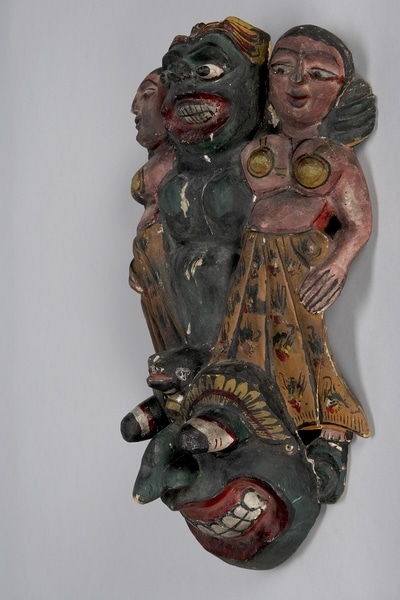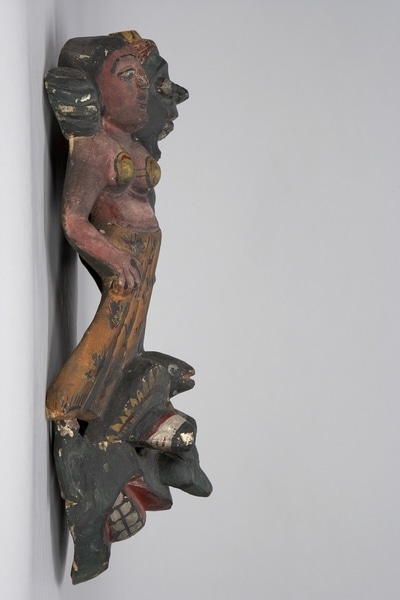Mask Item Number: Eh31 from the MOA: University of British Columbia




Description
Mask depicting a male humanoid face surmounted by a green male figure at the centre with his arms around two female humanoid figures on either side. The face is dark green with protruding eyes below which are crescent-shaped holes, arching eyebrows with a petal motif design, a protruding snake's head between the eyes, a nose with a bent bridge and wide flaring nostrils, a wide open mouth with red curved lips exposing gums and two rows of gray/white teeth, and small ears. The female figures each have dark pink skin, black hair and eyes, breast covers and full-length skirts with a floral design in dark red and black.
History Of Use
The Kolam is a secular entertainment with considerable elements of social satire. It incorporates narrative, mime, dance, and music. A Kolam performance usually has four episodes the precise content of which may vary. These consist of a prelude, detailing the origin of the drama; the arrival of a royal party and dances by characters mythical, human and animal; enactment of a popular story or stories; and a purifying demon dance. This mask represents Kalu Kumara or 'the black prince'. He shows himself in 7 apparitions. He is also used in a ceremony known as the Kohomba Kankariya, performed to assure general prosperity and freedom from disease for a village. He is associated with 'ratta yakku', demons causing barrenness and other afflictions on women and children.
Iconographic Meaning
Black skin, large protruding eyes, hanging lips and long white teeth are symbolic of a class of demon who brings disease and death. Only the lower part is a real mask; the mask and the figures on it represent the same demon. Only man-eating demons are represented by this type of structure.
Cultural Context
exorcism
Item History
- Made in Sri Lanka before 1978
- Collected during 1978
- Owned by Jason Schoonover before February 10, 1981
- Received from Museum of Anthropology Shop Volunteers (Funding source) and Jason Schoonover (Seller) on February 10, 1981
What
Who
- Culture
- Sinhalese
- Previous Owner
- Jason Schoonover
- Received from
- Museum of Anthropology Shop Volunteers (Funding source) and Jason Schoonover (Seller)
Where
- Holding Institution
- MOA: University of British Columbia
- Made in
- Sri Lanka
When
- Creation Date
- before 1978
- Collection Date
- during 1978
- Ownership Date
- before February 10, 1981
- Acquisition Date
- on February 10, 1981
Other
- Condition
- fair
- Current Location
- Case 106
- Accession Number
- 0704/0030